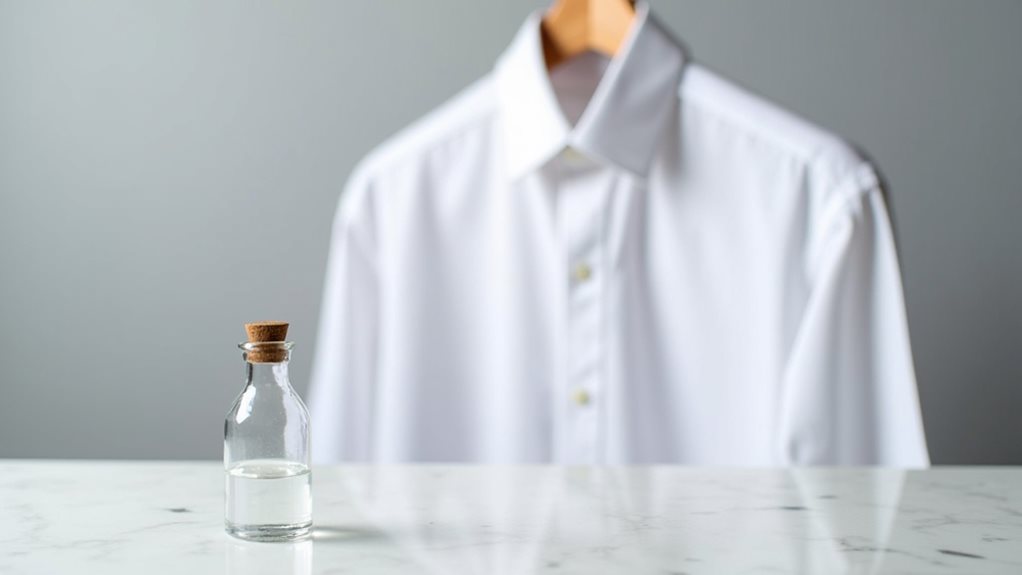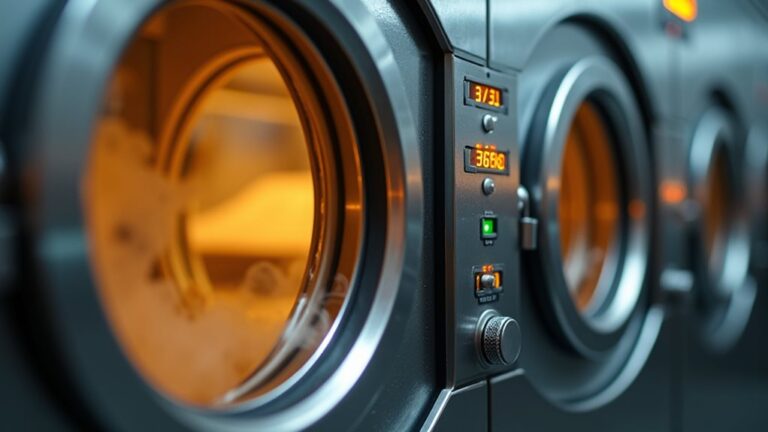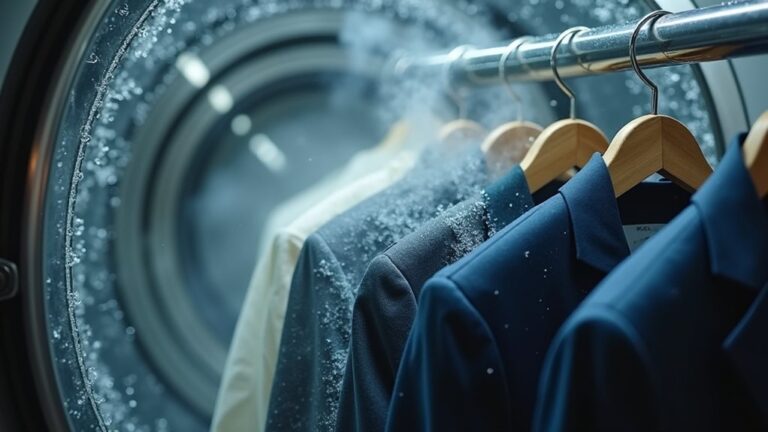Yes, dry cleaning absolutely cleans your clothes using chemical solvents instead of water, making it incredibly effective at removing oil-based stains like grease and food spills that would laugh at your regular detergent. You’ll find it’s particularly brilliant for delicate fabrics like silk, wool, and velvet since the gentle process prevents shrinking, fading, and those heartbreaking wardrobe disasters we’ve all experienced. Understanding the complete process reveals why it’s often superior to traditional washing.
What Is Dry Cleaning and How Does It Work?
When I first encountered dry cleaning as a college student with exactly one “fancy” blazer that I’d somehow managed to stain with pizza grease 😅, I honestly thought the name was misleading – how could something be cleaned without getting wet?
Turns out, this cleaning method uses chemical solvents instead of water to tackle dirt and stains. The primary solvent, perchloroethylene, works like magic on oil-based stains that would laugh at regular washing machines.
Your garments get gently agitated in this solvent inside a specialized dry cleaning machine, where the chemicals dissolve stubborn spots without penetrating fabric fibers.
This process is particularly brilliant for delicate fabrics that would shrink, fade, or lose their shape in water. The dry cleaning process preserves your clothing’s original texture and fit while effectively removing what water-based cleaning can’t touch.
After the solvent treatment, garments go through a drying and pressing phase to restore their original appearance and professional finish.
The Science Behind Dry Cleaning Solvents
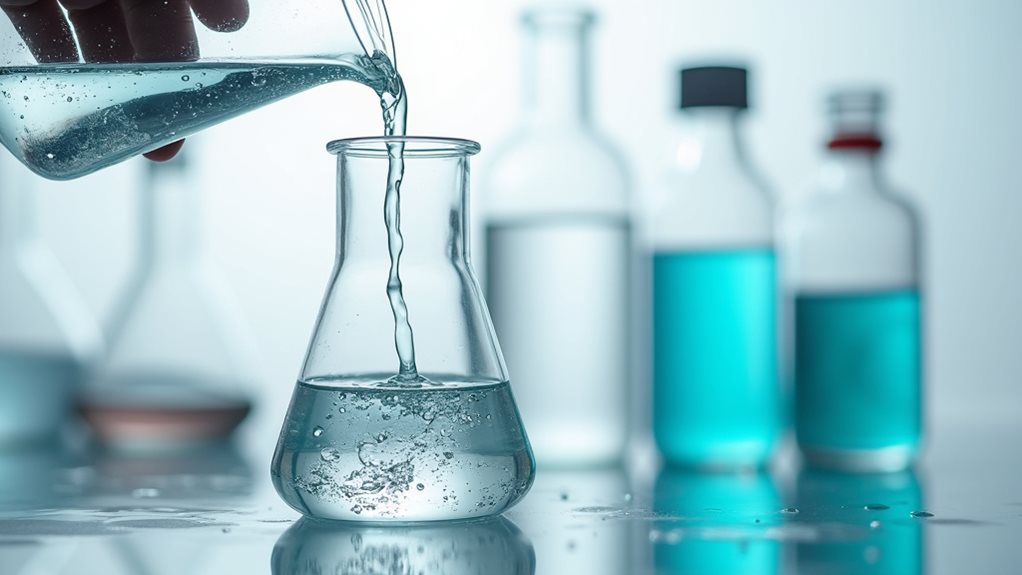
You’ve probably wondered how those mysterious solvents actually tackle stubborn stains that water can’t touch, and honestly, I used to think it was pure magic until I learned about the fascinating chemistry happening inside those tumbling machines.
The secret lies in understanding how different types of cleaning solvents—from traditional perchloroethylene to newer eco-friendly alternatives—work their molecular magic on everything from your favorite silk blouse to that expensive wool coat you spilled red wine on last winter 😅.
Before you drop off another load of dry cleaning though, it’s worth knowing about the health and safety considerations that come with these powerful chemical solutions, because knowledge truly is power when it comes to making informed choices about your clothing care.
Interestingly, the dry cleaning industry has evolved significantly from its early days when carbon tetrachloride was the go-to solvent, before being phased out due to serious health risks including liver toxicity and potential carcinogenic effects.
How Solvents Work
Although I used to think dry cleaning was just fancy washing without water, the science behind those mysterious solvents actually reveals a fascinating world of molecular chemistry that’s more clever than I ever imagined.
When you drop off that silk blouse, the dry cleaning solvent — usually perchloroethylene — works like a molecular magnet, attracting and dissolving oil-based stains through its non-polar nature.
The cleaning processes combine chemical action with mechanical agitation, creating friction that breaks down embedded dirt while solvents penetrate fabric fibers without causing swelling.
Before the actual cleaning begins, every garment undergoes garment inspection and tagging to identify specific stains and determine the appropriate treatment method.
Modern facilities are increasingly adopting environmentally friendly solvents like high flash hydrocarbons and liquid CO2, proving that effective cleaning doesn’t require harsh chemicals that make us worry about our planet’s future.
Types of Solvents
Perchloroethylene might sound like something from a chemistry textbook that made you want to take a nap, but this powerful solvent has been the backbone of dry cleaning for decades because it’s incredibly effective at dissolving those stubborn oil-based stains that water can’t touch.
However, the cleaning process has evolved beyond just perc, and you’ll find eco-friendly alternatives making their mark in modern facilities. Hydrocarbon solvents offer safer handling, while liquid carbon dioxide provides non-toxic, reusable cleaning power that’s gentler on both fabrics and the environment.
Siloxane-based solvents break down into harmless components, though they’re still being studied for safety. The key is that all these dry cleaning solvents work by surrounding and lifting away oils and grease, giving your delicate garments the deep clean they deserve.
This cleaning method is essential for delicate synthetics and natural fibers like silk and wool that would be damaged by traditional water-based washing methods.
Health and Safety
When I first started researching dry cleaning solvents, I’ll admit I naively thought the biggest health concern might be getting a mild headache from that distinctive chemical smell that hits you when you walk into a dry cleaner’s shop.
Boy, was I wrong! The reality about perchloroethylene’s health risks hit me like a ton of bricks – this stuff’s classified as a probable carcinogenic substance.
Here’s what you should know about protecting yourself:
- Proper ventilation systems reduce inhalation risks considerably
- Workers following safety measures show cancer rates similar to wet cleaning employees
- Alternative solvents like liquid carbon dioxide offer lower environmental impact
- Regulatory frameworks continuously improve dry cleaning industry standards
To minimize exposure risks, always let freshly dry-cleaned items air out completely before wearing them, as residual chemicals can remain on clothing and pose health concerns.
The good news? The industry’s evolving toward safer practices daily!
Types of Stains Dry Cleaning Can and Cannot Remove
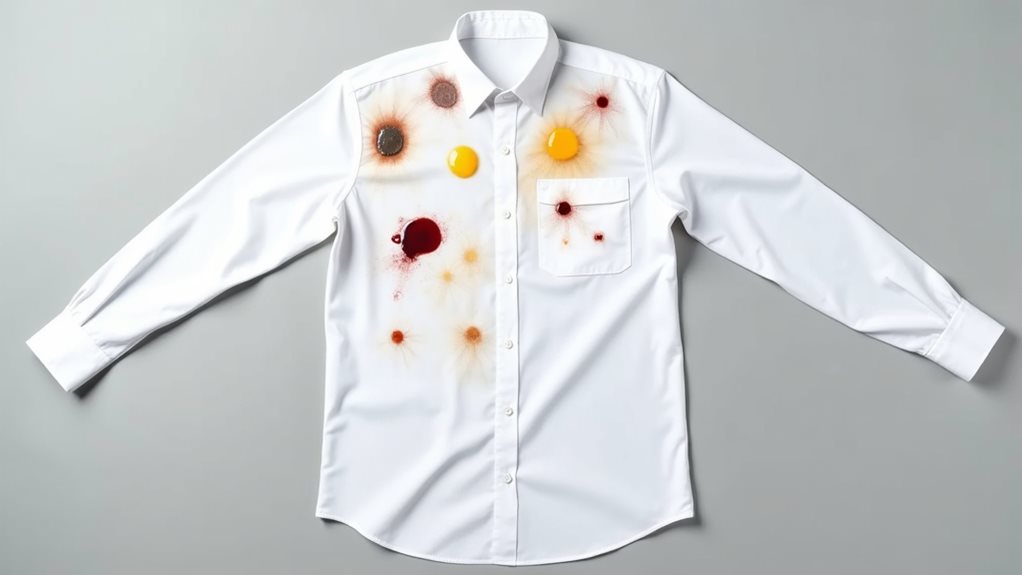
Since I learned the hard way after ruining my favorite silk blouse with a DIY stain removal attempt, I’ve discovered that understanding which stains dry cleaning can tackle—and which ones it can’t—will save you both heartache and money.
Oil-based stains like grease, tar, and food spills practically vanish with dry cleaning’s non-polar solvents, making it your best friend for effective cleaning of these stubborn marks.
However, water-based culprits like coffee and wine can be trickier, especially when they’ve settled into fabrics over time. Ink, bleach, and certain dyes might be permanent no matter what you try.
The success of oil stain removal largely depends on whether any previous attempts at removal have been made, as these can actually set the stain deeper into the fabric.
Here’s my golden rule: prompt addressing of any stain, combined with telling your cleaner exactly what happened, dramatically improves your chances of restoration success.
Fabrics That Benefit Most From Dry Cleaning
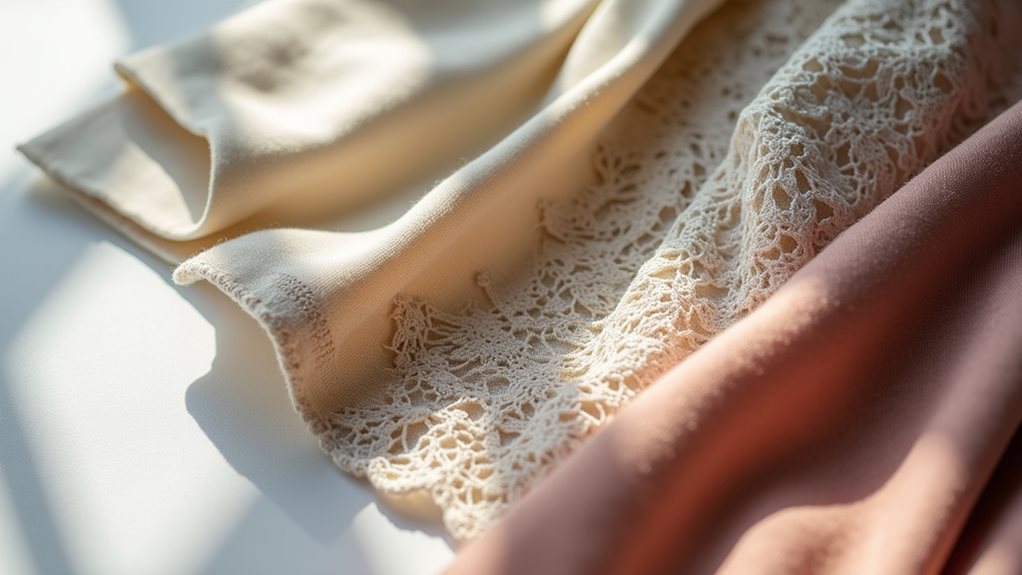
Beyond understanding which stains respond best to professional treatment, I’ve learned through countless wardrobe mishaps that certain fabrics practically beg for the gentle touch of dry cleaning.
Choosing the right cleaning method can mean the difference between preserving your favorite pieces or watching them transform into expensive cleaning rags.
These fabrics need special attention to maintain their beauty and structure:
- Luxury materials like wool, silk, and velvet that shrink with water-based cleaning
- Delicate items featuring sequins, beading, or intricate lace details
- Specialty fabrics including rayon and acetate that distort when wet
- Garments with linings such as customized jackets requiring synchronized care
Traditional dry cleaning protects these sensitive materials through cleaning without water’s harsh effects, preserving both appearance and longevity. The process uses chemical solvents instead of water to remove dirt and stains while maintaining the fabric’s original integrity, shape, and texture.
Comparing Dry Cleaning Effectiveness to Traditional Washing
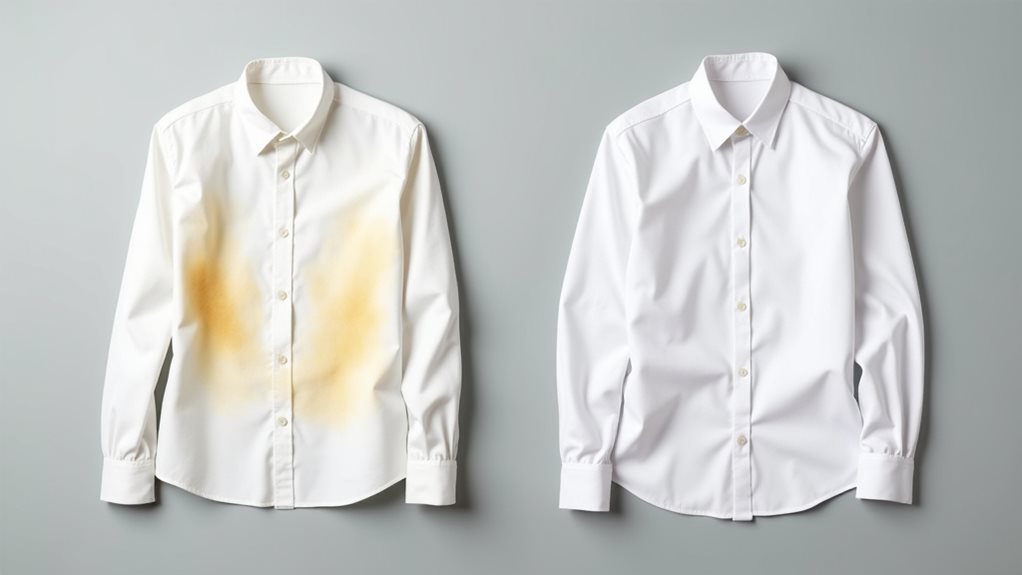
When you’re standing in your closet holding that wine-stained silk blouse, wondering whether your trusty washing machine can handle it or if you need to make that trip to the dry cleaner, you’re fundamentally weighing two completely different cleaning philosophies that each excel in their own territories.
Your regular washing machine might conquer that coffee spill on your cotton shirt like a champion, but it could turn your favorite wool sweater into something that would fit your niece’s teddy bear 🧸, while dry cleaning protects those delicate fibers but might leave you scratching your head over why it costs three times more than a regular wash.
The truth is, both methods have their sweet spots when it comes to stain removal capabilities, fabric protection methods, and that eternal question of whether the cost truly matches the results you’re getting.
Dry cleaning uses chemical solvents like perchloroethylene instead of water to dissolve oils and greases that traditional washing simply cannot tackle effectively.
Stain Removal Capabilities
How effectively does dry cleaning tackle stubborn stains compared to your trusty washing machine, and honestly, the answer depends entirely on what you’ve managed to spill on yourself this time.
Here’s what each method handles best:
- Oil-based stains (grease, tar, makeup) – dry cleaning wins hands down
- Water-based stains (coffee, wine, sweat) – your washing machine takes the crown
- Delicate fabrics – dry cleaning protects silk and wool beautifully
- Heavy-duty cleaning – traditional washing provides stronger agitation
The magic lies in non-polar solvents used during the dry cleaning process, which dissolve greasy messes without the fiber swelling that water causes.
That quick 8-15 minute cleaning cycle might seem gentle, but it’s surprisingly effective at stain removal when you’ve got the right enemy.
Professional dry cleaners often combine chemical solvents like perchloroethylene with additional water-based treatments when dealing with particularly challenging stains that require both approaches.
Fabric Protection Methods
Stain removal is only half the battle though, because protecting your favorite clothes from damage during the cleaning process matters just as much as getting them spotless.
When dry cleaners use specialized fabric protection methods, they’re fundamentally giving your garments a spa day instead of a rough workout. The solvent in dry cleaning doesn’t cause fibers to swell like water does, which means your delicate fabrics won’t shrink, stretch, or lose their shape.
Traditional washing can be brutal on silk blouses and wool sweaters, causing them to become unwearable disasters. Cleaning chemicals in dry cleaning are gentler on embellishments and dyes, preventing that heartbreaking moment when your favorite dress comes out looking like a tie-dye experiment gone wrong.
Garments with complex linings or multiple fabric types are particularly vulnerable to damage from conventional washing and require professional dry cleaning to maintain their structural integrity.
Always check garment care labels first!
Cost Versus Results
Most people’s wallets start crying when they see dry cleaning prices, but here’s the honest truth from someone who learned this lesson the hard way: sometimes paying $8 for professional services beats ruining a $200 dress with your washing machine’s “gentle” cycle.
When you’re weighing cost versus results, consider these realities:
- Delicate fabrics like silk and wool shrink or lose shape in regular washing.
- Specialized solvents remove oil-based stains your detergent can’t touch.
- Professional equipment preserves color and texture better than home machines.
- Replacement costs often exceed dry cleaning fees for damaged garments.
Sure, dry cleaning struggles with water-based stains, but for your “dry clean only” pieces, that $7-10 investment protects expensive clothing while delivering superior results you simply can’t achieve at home.
The Complete Dry Cleaning Process Step-by-Step
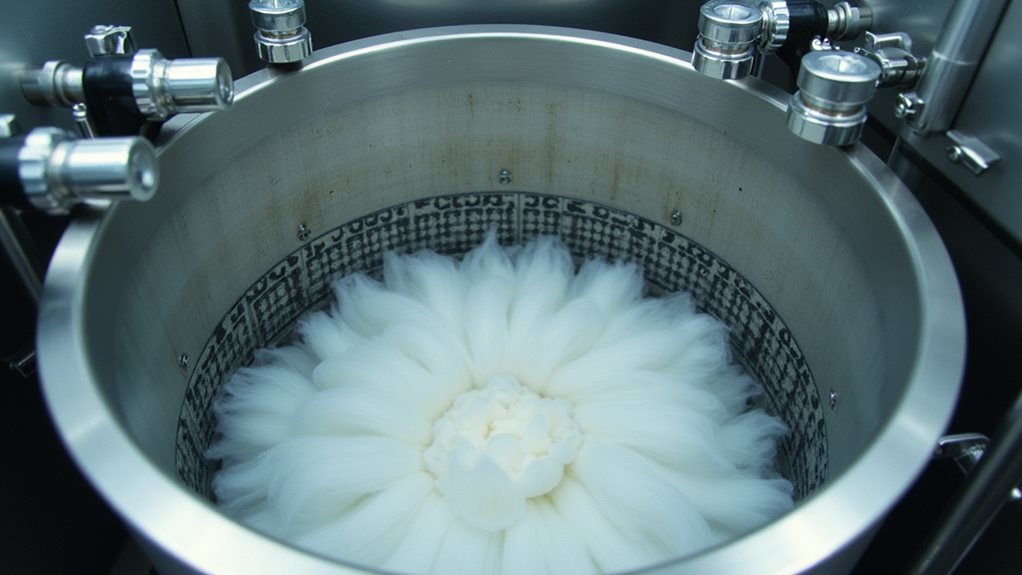
When I first watched a dry cleaner work their magic on my favorite silk blouse, I couldn’t help but marvel at the methodical dance that transforms dirty garments into pristine pieces.
Honestly, understanding this process helped me appreciate why professional cleaning costs what it does. The dry cleaning process starts with garment tagging, where your items receive unique identifiers for tracking—think of it as a GPS for your clothes!
Next comes thorough inspection and pre-treatment of stains using specialized chemicals, because stubborn spots need extra attention before meeting the cleaning machine.
Inside that machine, organic solvents like perchloroethylene work without water to dissolve oil-based stains through gentle agitation.
After a second inspection verifies everything’s perfect, finishing touches like pressing and steaming complete your garment’s transformation ✨
Environmental and Safety Considerations of Dry Cleaning
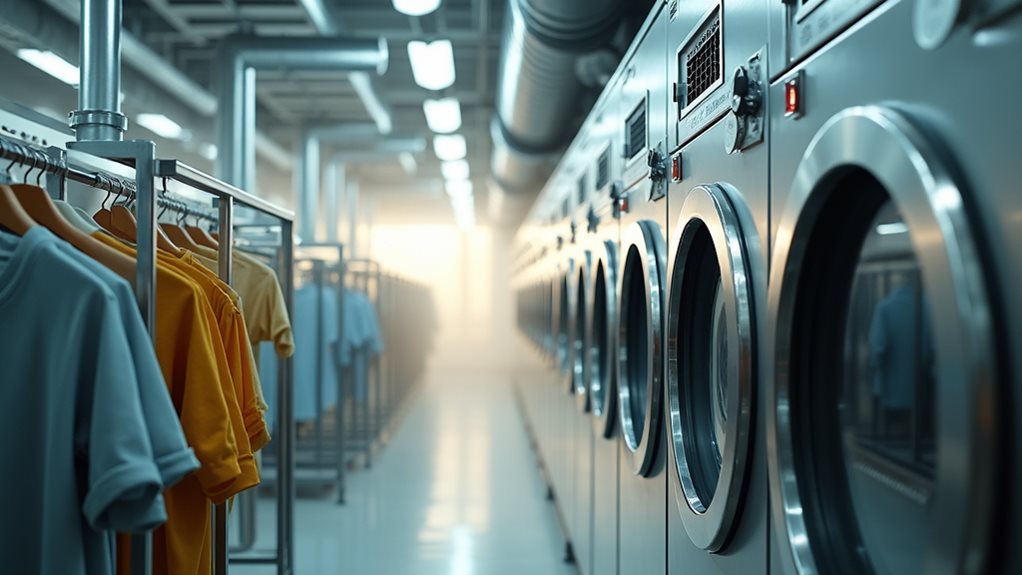
Although I’d never given much thought to what happens to those cleaning chemicals after they work their magic, learning about dry cleaning’s environmental impact honestly made me reconsider some of my garment care choices.
The industry’s reliance on perchloroethylene brings serious environmental risks, including groundwater contamination and volatile organic compound emissions that affect air quality.
Here’s what you should know about safer alternatives emerging in the industry:
- Wet cleaning uses biodegradable detergents and specialized equipment
- Liquid carbon dioxide cleaning eliminates toxic solvents entirely
- High flash hydrocarbons reduce health effects compared to traditional methods
- Silicone-based solvents offer gentler cleaning with minimal environmental impact
Many cleaners now adopt eco-friendly practices, responding to EPA regulations and customer demand for healthier options.
Getting Maximum Results From Professional Dry Cleaning Services

Since discovering how much my favorite wool blazer improved after sharing details about a mysterious stain with my dry cleaner, I’ve realized that getting exceptional results from professional dry cleaning services isn’t just about dropping off your clothes and hoping for the best.
You’ll want to check garment labels first, as they’re like roadmaps for proper cleaning methods that protect your investment. When you communicate stain details—whether it’s red wine or cooking oil—your cleaner can target specific treatments for better stain removal.
Don’t attempt home remedies on “dry clean only” items, as you’ll likely cause more damage than good. Ask about eco-friendly options too, because professional dry cleaning done right can genuinely extend lifespan while keeping your conscience clear.

